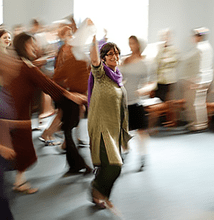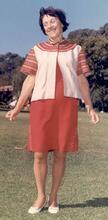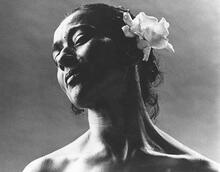Rivka Sturman
Born in Poland in 1903, Rivka Sturman grew up in Leipzig, Germany, a cultural center of Europe. In Leipzig and Berlin, she studied modern dance and explored dance’s ability to allow individuals to experience joy and cultivate free expression. With her husband, she emigrated to Palestine, where she lived on a kibbutz and began choreographing plays that held on to old traditions while still incorporating influences of the Diaspora. In this environment, Sturman began to pioneer Israeli folk dance, influenced by Bedouin dances, Yemenite dances, Biblical ballet, and hasidic dances. She created approximately 150 dances and worked hard to make them popular in Israeli culture, creating a “Program for Teaching Folk Dance and Games to Preschoolers” so that folk dance would become a fundamental part of national education. On Israel’s thirtieth anniversary, the Israeli government published eight of her dances in a booklet entitled, “The School Dances.”
Overview
One day in 1942, as Rivka Sturman was walking along the paths of her A voluntary collective community, mainly agricultural, in which there is no private wealth and which is responsible for all the needs of its members and their families.kibbutz, En-Harod in the Jezreel Valley, she heard second-grade pupils planning their class party and dancing to the tune of a well-known German song. According to Rina Sharett, Rivka asked herself: “How is it that we, the pioneers, who established this character of the ‘new Jew’ who works the land, lives in a collective and speaks Hebrew, nevertheless sing and dance in a foreign language?”
At the time, the immigrants to the country danced the folk dances of their countries of origin, primarily dances from the Slavic countries and the Balkans. With considerable misgivings, Sturman sought to create Israeli folk dance, to be based on the principles of simplicity and honesty: “A minimum of movement to express a maximum of feeling.”
A pioneer of Israeli folk dance, Sturman devoted herself to creating Israeli folk dances “so that En-Harod’s children will dance in Hebrew,” at a time when many people believed that folk dances were not choreographed but rather developed as a result of a long process of group activity spanning many generations. She choreographed the first dances that established the style and character of Israeli folk dance.
Early Life and Education
Rivka Weinwurzel was born in Warsaw in 1903, the youngest of six children, two boys and four girls. In 1905 the family emigrated to Leipzig in eastern Germany, a city which was at the time a cultural center, known as “little Paris,” “the city of rococo and enlightenment.” Her father, Ya’akov, was a lace merchant and her mother, Genia, helped with sales.
At seventeen, Rivka completed her studies at the Jewish high school founded by Dr. Ephraim Carlebach, who had a great affinity for art and aesthetics. As an adolescent, Rivka met Gert Kaufman, later known as Gurit Kadman, a physical education teacher and dancer who was then a member of A voluntary collective community, mainly agricultural, in which there is no private wealth and which is responsible for all the needs of its members and their families.Kibbutz Hefzibah and came to Leipzig as a guest of Rivka’s family. Following the example of her sister Eva, Rivka joined the German Jewish youth movement, Blau-Weiss.
During the 1920s, Rivka studied at a Pestalozzi seminary for kindergarten teachers in Leipzig and then went to a farm near Berlin to study agriculture. There she met her husband-to-be, Menahem Sturman, and joined the He-Halutz pioneer movement. The couple eventually had two children: Dalia (1934–1983) and Hayyim (b. 1938).
Dance in Germany
In Berlin, Rivka continued the modern dance studies she had begun in Leipzig. Her teacher Jutta Klamet stressed student creativity and free expression, correct breathing, self-awareness and reverence for the knowledge of the ancient East. This was the Germany of the 1920s, in which expressive dance blossomed, exemplified by Mary Wigman (1886–1973) and Kurt Joos (1901–1979), both students of Rudolf von Laban (1879–1958). They were all part of the same “historical movement of liberalism and optimism, the philosophy of individual freedom and emphasis on expressing the ‘I,’ and yearning for the mysticism of the East.” At the same time Rivka also worked in a Jewish orphanage in Berlin run by Dr. Siegfried Lehmann (1892–1958): “I worked with children who knew suffering and saw that they could experience joy through dance. At times of despair and loneliness, dance is supportive and communicative, and they taught me the meaning of serving humanity through dance,” she said in a lecture on “The Essence of Dance,” which she delivered at the Manya Bialik House in 1978.
In 1925, Rivka visited Palestine to meet her husband’s family, who lived in Nahalal and Kefar Giladi. From her stay at the latter, Rivka remembered the horah that the pioneers danced in the first and only house in the village. In those days, no one asked whether the horah was an original Israeli dance or one borrowed from other peoples, or a religious hasidic dance. They danced the horah simply as a primal expression of the individual in society, as a dance that expressed the character of pioneer life, the social atmosphere of the pioneers and their strong feelings about equal rights for everyone, men and women alike.
After a year in Palestine, Rivka Sturman returned to Berlin where she worked fundraising and organizing events for Keren ha-Yesod while studying anatomy and orthopedic treatment.
Dance in Palestine
Rivka and Menahem emigrated in 1929, settling in Kefar Yehezkel. Menahem, who had completed his veterinary studies in Berlin, was appointed veterinarian of all the agricultural settlements in the Jezreel Valley. In Kefar Yehezkel, Rivka prepared her first, modest performance, and also taught self-defense to members of nearby Kibbutz En-Harod. Twenty years later, the movements from the self-defense class reappeared in “Debka Gilboa,” a dance which contains back and forth movements of retreat and attack, inspired by the battle for the Gilboa during the War of Independence and the heroism of King Saul and his son Jonathan.
In 1931 Rivka returned to Berlin to continue studying therapeutic gymnastics. She returned to Kefar Yehezkel in 1933 and the next year moved with her husband to En-Harod. She continued to study dance in Tel Aviv with Gertrude Kraus, Paula Padani and Tehilla Ressler (1907–1959).
During this period Sturman choreographed the plays with large casts produced at Kibbutz Geva by kibbutz member Yitzhak Ben Yosef. These included Bar Kokhba by Saul Tchernichowsky (1875–1943) and The Wall (The Wall of Agrippas) by Aharon Ashman (1896–1981). Through this work she also formed a connection with the composer Emanuel Amiran (1909–1993), who wrote the music for some of her dances, which were stage pieces rather than Israeli folk dances.
Fostering Israeli Folk Dance
The major turning point came as a result of the aforementioned encounter with the children of En-Harod, her daughter Dalia’s classmates. To this was added the impact of a performance at En-Harod of international folk dances presented by a troupe from the Ben Shemen Youth Village, who made a great impression on the local youngsters. The educational principles of Dr. Siegfried Lehmann, principal of the Ben Shemen Youth Village, were based on the call of Jean Jacques Rousseau (1712–1778) to return to nature—a call that translated into the ideology of both the German and the Israeli youth movements: the fostering of rural culture, revival of nature festivals and longing for the ancient roots of the Land of Israel, all as a response to the “negation of the Lit. (Greek) "dispersion." The Jewish community, and its areas of residence, outside Erez Israel.Diaspora.” Dr. Lehmann conceived of an ancient religion that was not restricted to a particular ethnic or religious setting but could serve all human beings, irrespective of class differences. As a result, he did not rule out the folklore of other nations.
At the time there was a great deal of cultural activity at Kibbutz En-Harod and a significant increase in the number of people with talents in various cultural areas. It was in fact the first kibbutz to be established according to the concept of the “large kibbutz” as distinct from the selective “small kibbutz,” such as Kinneret or Deganiyyah. En-Harod’s members believed that: “We have the way practiced by Jews everywhere: to join what is coming into being with what was created generations ago. We need to combine, continue and augment ourselves, playing the old melody with new notes that arise from the experience of our newly revived existence.”
Kibbutz En-Harod’s approach was expressed thus: “To skip over the Diaspora, continue the old tradition, and distance ourselves from all religious expression. To renew, without neglecting the old; to revive what is most ancient and to feel the present experience—to find the right way among all these contradictions.” The kibbutz members devoted a great deal of thought and effort to this process. In this unique cultural climate, Sturman began her journey to Israeli folk dance. For her it was a beginning, but for En-Harod it was the outcome of a twenty-year search. At En-Harod Sturman choreographed Ha-Goren (The Barn Floor, 1942), her first folk dance, to a tune by Emanuel Amiran and words by Sara Levi Tanai. According to Rina Sharett, Sturman frequently asked herself: “How has it happened that I am the pioneer of Israeli folk dance?” Sharett explains: “The simple answer was that she was there, she, Rivka Sturman, a personality, a creative pioneer, filled with a desire to serve society, there, at En-Harod.” Sturman later recalled that the urge to create folk dance awoke within her out of that desire to negate the Diaspora which was characteristic of the Zionism that led her to emigrate. At the time she was unimpressed by the dances of Yemenite Jews, which she encountered at the end of the 1940s, seeing them as intended only for their own community. Similarly, she was unable to combine the elements of Jewish dances from the east and west into a uniform Israeli folk dance, since they seemed to her important to tradition but alien to the country’s youth. The dances of her Arab neighbors, on the other hand, attracted her attention and inspired her, since she felt they were at one with the landscape and nature common to both peoples.
Combining Dance and Education
By the 1950s Sturman was already drawing on Bedouin dances, on Yemenite dances performed by Rahel Nadav’s group, on the Rina Nikova Biblical ballet and on hasidic dances. Among the first dances she created were many children’s dances for festivals such as the Omer Festival and Lit. "weeks." A one-day festival (two days outside Israel) held on the 6th day of the Hebrew month of Sivan (50 days, or 7 complete weeks, from the first day of Passover) to commemorate the Giving of the Torah on Mount Sinai; Pentecost; "Festival of the First Fruits"; "Festival of the Giving of the Torah"; Azeret (solemn assembly).Shavuot. She learned a great deal from the children’s responses. Indeed, throughout her life Sturman concentrated on working with children, in the belief that dance was important for teaching a sense of rhythm, natural movement, comfort with one’s surroundings, interpersonal connections and listening skills. She felt that teaching folk dance at school was a way to get every child to dance, not just to foster the abilities of a talented few, and that teaching dance must begin in the early grades in order to involve all the children in an uninhibited manner. Rivka Sturman learned from experience that when a true collaboration exists between the dance teacher and the homeroom teacher, whatever the class is learning at the time can also serve as a subject for study during dance instruction.
In the mid-1940s Rivka Sturman was still unsure as to what constituted Israeli dance. She sensed what was “not Israeli, not appropriate,” but found it difficult to define what was. The special rhythm in the melodies of Sara Levi-Tanai spurred her to create the Za’ad Ni’ah (hopping step) which became the basis of so many Israeli folk dances. Several syncopated melodies by composer Emanuel Amiran greatly influenced her and seemed to her the proper rhythm for Israeli dance.
Dance Repertoire
In 1942, after Ha-Goren, Sturman composed the dance Ve-Hittifu he-Harim Asis (And the Mountains Shall Drip Wine) and in 1943, Hushu, Ahim, Hushu (Hasten, Brothers, Hasten). In 1945 she choreographed Kumah, Eha (Arise, My Brother) and Harmonica, which are still popular. Kumah, Eha was an expression of what Sturman experienced when the tower-and-stockade settlement Kibbutz Sedeh Nahum was established on January 5, 1937, in the eastern Jezreel Valley. The melody was by Shlomo Postolsky, a member of En-Harod, and the words by the poet and writer Yitzhak Shenhar (1902–1957). The song describes the special quality of the horah: “No beginning here or end; hand in hand, do not let go.”
In 1946 Sturman choreographed Kol Dodi (My Beloved’s Voice) to music by Sarah Levi-Tanai. She also choreographed Ozi v-Zimrat Yah (God is My Song and Strength) to a Yemenite folk melody she learned from young Yemenites who came to work in the settlements. The influence of Yemenite dance is evident in Be-Mehol ha-Shnayim (Dance for Two), a dance for couples which she choreographed; in Dodi Li (My Beloved Is Mine) of 1948; and in Ve-Iti mi-Levanon (With Me from Lebanon), created in 1949. These dances were choreographed following a conversation with an adolescent girl from En-Harod, from which Sturman learned of young people’s need for couple-dances. In 1947 she choreographed El ha-Rahat (To the Drinking Trough) and in 1948 Le-Or Havazzelot (By the Light of Lilies). These were simple dances for children and the general public. Afterwards came Im Hupalnu (If We Were Knocked Down, 1949), Hineh Mah Tov (See How Good, 1950); Zemer Lakh (A Song for You, 1950); Nizzanim Niru ba-Arez (Buds Are Seen In the Land); Megadim (Choice Fruits); Shu’alim Ketanim (Little Foxes, 1950); Va-Yiven Uzziyahu (And King Uzziah Built, 1952); Ahavat Hadassah (Love for Hadassah), Horah Eilat, and Ve-David Yefe Einayim (David of the Beautiful Eyes, 1953); Yarad Dodi Le-Ganno (My Beloved Has Gone Down to His Garden, 1955); Zemer Atik (Ancient Song, 1956); Eh ha-Tal (Where Is the Dew, 1957); Eten Ba-Midbar (I Shall Plant in the Desert, 1959)—about one hundred and fifty dances in all. Many of these are still popular, while many dances choreographed today are based on the basic steps of Sturman’s dances.
Festival vs Folk Dances
In an essay entitled “For the Third Folk Dance Convention at A voluntary collective community, mainly agricultural, in which there is no private wealth and which is responsible for all the needs of its members and their families.Kibbutz Daliyyah,” which was published in an En-Harod newsletter on April 15, 1951, Rivka Sturman contended that one must distinguish between festival and performance dance, on the one hand, and folk dance on the other. She felt strongly that folk dance required encouragement and special conditions in order to grow and develop and that overemphasis on display and stage performance interfered with the development and integration of original folk dance. In her correspondence with Gurit Kadman, Sturman wrote: “We must learn how to present a simple folk dance to the public in an interesting way that will win them over.”
In an article for the December 22, 1970 edition of the En-Harod newsletter, entitled, “The Future of Israeli Folk Dance,” Sturman wrote: “After twenty years of organized activity, we have still not made an impression on the people. People do not dance any of our new dances spontaneously, only the horah and couple dances that were ‘naturalized’ over twenty years ago. Apparently we do not know how to impart them to people and make them popular.” In the article, Sturman suggests distinguishing between the two main requirements of a dance: on the one hand, it must be pleasant and entertaining, with music, movement and rhythm in the spirit of the time; and on the other hand, it must at all costs preserve the original folkloristic characteristics, with the clear intention of preserving tradition.
Nationalizing Dance in Education
In the mid-1970s Sturman proposed a “Program for Teaching Folk Dance and Games to Preschoolers” to the Ministry of Education and Culture. The dances she created so that the children of En-Harod would have Israeli dances as the ones they learned at the beginning of their schooling served as the basis for the national program she formulated. Eight of Sturman’s dances were among the thirty included in the booklet, “The School Dances,” which the Ministry of Education and Culture published on Israel’s thirtieth anniversary.
At the end of the 1980s Sturman reflected a great deal on the past. In summing up past and future she wrote: “In every period, from 1940 until today, I have given joy and happiness in life to many people. … But what working in dance has done for me is immeasurable. Dance gave me happiness and wisdom. … Sometimes I think that I would still like to create at least one more dance.”
Eshel, Ruth. Dancing with the Dream: The Beginning of Artistic Dance in Israel, 1920–1964. Tel Aviv: 1991, 87–93.
Ronen, Dan. “The Fiftieth Anniversary of Israeli Folk Dance” (Hebrew). Dance in Israel 4 (October 1994): 5–53.
Idem. “Men Reap, Women Gather Sheaves” (Hebrew). Dance Now 4 (March 2001): 39–45.








